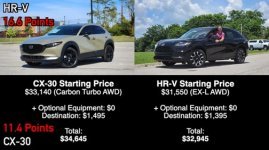 Performance & Engine
Performance & Engine
- 2026 Honda HR‑V: Powered by a 2.0-liter inline‑4 with 158 hp and 138 lb‑ft, paired to a CVT. Offers FWD standard, AWD optional. 0–60 mph in approx. 9.8–9.4 seconds depending on drivetrain. Real‑world feel can be underwhelming in some situations
- 2025 Mazda CX‑30: Base 2.5 L engine produces 191 hp (or 186 hp engine variants), with an optional turbo version up to 250 hp. AWD standard, paired with a 6‑speed automatic. Turbo trim accelerates to 60 mph in just 5.8 seconds
Verdict: For spirited driving and acceleration, the CX‑30—especially the turbo variant—has the clear edge.

 Handling & Driving Feel
Handling & Driving Feel
- HR‑V: Smooth, composed ride with light steering; suspension is independent front and rear, providing stable handling. Narrow powerband and CVT detract from dynamic feel
- CX‑30: Sharper, sport‑tuned ride thanks to AWD and firmer suspension. Steering is precise and feedback-rich. Comfortable yet responsive
 Interior & Cargo Space
Interior & Cargo Space
- HR‑V: More spacious overall: 41.9″ front / 37.7″ rear legroom, 24.4 cu ft cargo (up to 55.1 cu ft folded). Cabin design is functional but more utilitarian
- CX‑30: Slimmer cabin: 41.7″ front / 36.3″ rear legroom, 20.2 cu ft cargo (expandable to 45.2 cu ft). Premium materials, minimalist layout gives a luxury impression
 Tech & Infotainment
Tech & Infotainment
- HR‑V: Comes with a standard 9″ touchscreen, wireless Apple CarPlay/Android Auto on all trims, wireless charging, and adaptive cruise. Higher trims add blind‑spot monitoring and sensors
- CX‑30: Standard 8.8″ or optional 10.25″ display (turbo trims), Apple CarPlay/Android Auto (wired on most trims), available head‑up display, Bose premium audio (12-speaker), 360° camera, Traffic Jam Assist
 Fuel Economy & Safety
Fuel Economy & Safety
- HR‑V: EPA-rated at 26/32/28 mpg (FWD), 25/30/27 mpg (AWD). IIHS Top Safety Pick+, 5-star NHTSA rating. Safety suite includes Honda Sensing features as standard
- CX‑30: Base engine returns 26/33/29 mpg, turbo trim around 22/30/25 mpg. Also has IIHS Top Safety Pick+ and five-star NHTSA rating. i‑Activsense includes advanced features like surround-view and traffic jam assist
 Summary Comparison
Summary Comparison
| Feature | 2026 Honda HR‑V | 2025 Mazda CX‑30 |
|---|---|---|
| Engine / Power | 2.0 L, 158 hp | 2.5 L, 191 hp (250 hp turbo option) |
| 0–60 mph | ~9.4–9.8 s | Turbo: ~5.8 s |
| Drivetrain | FWD standard, AWD optional | AWD standard |
| Interior / Cabin | Roomier, practical | Premium feel, snugger |
| Cargo Capacity | Up to 55.1 cu ft | Up to 45.2 cu ft |
| Tech & Infotainment | 9″ screen, wireless CarPlay/Android Auto | Larger screens, more tech options, Bose audio, HUD |
| Fuel Economy | ~26/32/28 mpg (FWD) | ~26/33/29 mpg base; ~22/30/25 mpg turbo |
| Safety Ratings & Tech | Top scores, Honda Sensing included | Top scores, i‑Activsense with extra features |
| Driving Experience | Comfortable, smooth but unexciting | Sporty, engaging, agile |
| Pricing (MSRP) | ~$27,600 – $31,400 | ~$26,400 – $38,400 depending on trim |
 Insights from Drivers (Reddit Highlights)
Insights from Drivers (Reddit Highlights)
- HR‑V criticized by some for being sluggish (“maybe the slowest vehicle I've ever been in”; 0‑60 around 9.4 s) and less engaging
- CX‑30 often praised: “much more fun to drive,” better interior quality, though smaller rear space overall
 Final Advice
Final Advice
- Choose Honda HR‑V if you prioritize space, fuel economy, and a refined ride.
- Choose Mazda CX‑30 if you value driving dynamics, premium design, technology-rich cabins, and optionally turbo‑charged performance.
